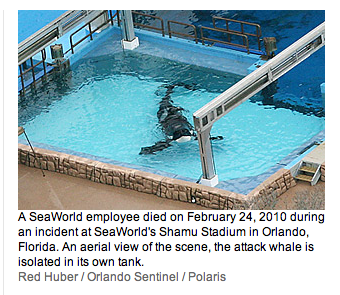The Killer Whale Attack at SeaWorld: How It Happened
 Courtesy of TIME, by Howard Chua-Eoan
Courtesy of TIME, by Howard Chua-Eoan
What led the killer whale Tillikum to attack and kill one of his SeaWorld Trainers in Orlando will not be known until behavioral records from the days and weeks preceding the incident are examined. But one thing is becoming clear. The attack was violent and bloody, perpetrated with a viciousness by one of the smartest of ocean species.
Tillikum did not just knock Dawn Brancheau and drag her down to drown at the bottom of the pool. According to a source, he rose out of the water to snag Brancheau by her ponytail, yanking her into the water for two brief but shocking episodes in the pool. After grabbing her by her hair, he toyed with her underwater for two minutes as she struggled to use trainer signals to calm him down and get him to release her. He knocked her about and, according to some reports, had her by the waist, her blood spreading through the clear water, in full sight of members of the public that had been watching Tillikum with another trainer through a glass underwater window.
She was still alive at the end of the first take-down when Tillikum let her go. But he watched as she tried to get to safety and then grabbed her again for another minute under water, this time apparently killing her. He then settled at the bottom of the pool, keeping her in his mouth. She apparently remained in his mouth until the staff at SeaWorld managed to beach him as they moved him to a separate pen. No one at SeaWorld was available to confirm reports that Brancheau’s body was very badly mangled. (A 2006 killer whale attack in San Diego.)
Killer whale trainer fatalities tend to be drownings, when the human is pushed down and kept underwater. In such situations, experienced trainers know to try calming the whale with signals even as they try to control their own panic. But the violence and abrupt nature of the attack on Brancheau has stunned many in the profession. She was one of the best and most experienced in the field, featured in many of SeaWorld’s promotions and advertising.
Whales like Tillikum that have gotten violent are likely to be separated from the rest of the performing troupe, kept in isolation and trained only by the most senior of staff. But the policy is generally not to destroy such animals — a policy that most trainers agree with. The trainers know the dangers they are in when they enter the water, fully aware that killer whales are dangerous animals. They point out that entertainments like those at SeaWorld are minutely choreographed, primed with long-practiced signals and rehearsed with great care, with constant attention to the whale’s psychology before and after the performances. The interaction between trainer and whale is key — with the onus on the human to notice how cooperative the animal is being. The word constantly heard is "love" — that the trainers love the whales. And they will bet their lives on them.


